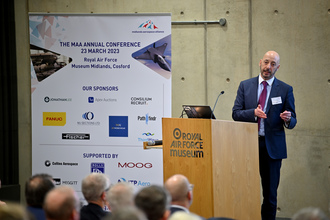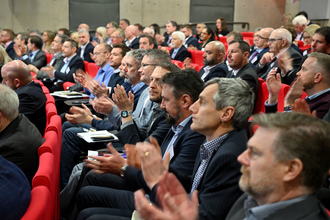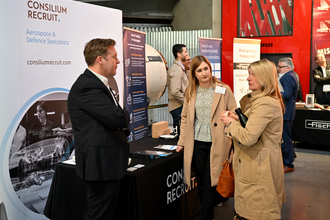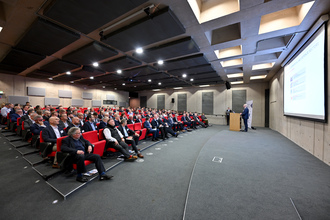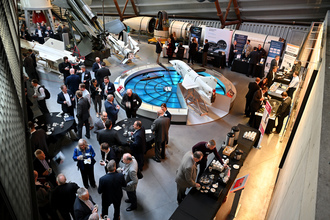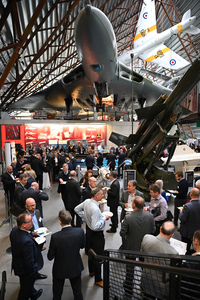MAA Conference explored exciting prospects for supply chain growth
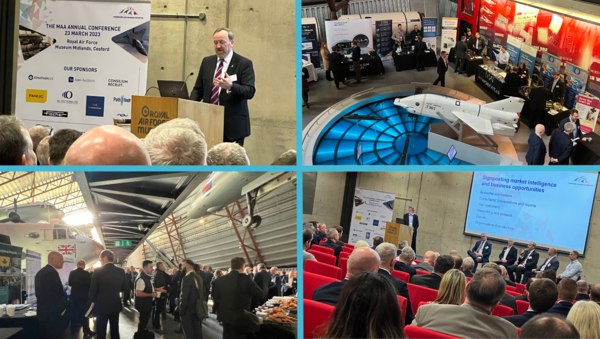
Over 150 professionals from every level of aerospace and defence supply chains gathered to explore the future of both sectors as well as a range of new and emerging industries, at the MAA’s annual conference recently. Right from the moment delegates stepped through the doors, the venue – the spectacular RAF Museum Midlands in Cosford – served as a reminder of the UK’s track record of innovation and the impact this continues to have.
The conference took delegates on a journey from the business opportunities of today – and how to make the most of them – to the potential markets of tomorrow and how they could get ahead.
New ways to discover market trends and business opportunities
Following a warm welcome from Chair of the MAA Board, Alan Dunbar, and the latest industry news from MAA Chief Executive, Dr Andrew Mair, a panel of experts gathered on stage to talk about how they source the latest information on the market to support their growth plans.
Chair of the MAA’s Business Development Working Group, Rob Holmes (VP Aerospace, Hardide Coatings), was joined on the panel by Andrew Kinniburgh (Director-General, Make UK Defence), Clive Lewis (Managing Director, Achieving the Difference), Michael Carlisle (Business Development Manager, Independent Forgings and Alloys) and Paul Blunden (Director, International Military Sustainment, Moog Aircraft Group). Together, they shared how they use networking, go-to reports, publications, events, organisations and insights from customers to optimise their strategies for growth and real business opportunities.
A survey of delegates, which was run live during the session, confirmed that MAA members value access to data and insights curated by industry experts. In response, the MAA has created a great new benefit for members: The MAA Market Intelligence Hub. The on-line hub will bring together a wide range of reports, publications, industry forecasts and more in one convenient place. The hub will continue to expand so that it always provides the latest sources of information to best support evolving businesses.
If you’d like to be one of the first to access the MAA Market Intelligence Hub, you can discover more about the great benefits of being part of the one of the most influential aerospace networks and join the MAA here.
The future of data and how it is already powering competitiveness
Stephen Burnside (Chief Economist 3.0, Rolls-Royce) shared insights into how the primes are using AI and advanced data sources to drive decisions and be at the forefront of the market. The faster companies like Rolls-Royce can source data and respond, the greater the opportunity to enhance efficiency, avoid risks, maximise margins, and enhance revenue. He shared examples of how data is used in surprising ways to forecast customer requirements – even before they know what they want.
Stephen demonstrated just how important it is for supply chain companies to be driven by real data rather than intuition. Companies that use data to anticipate upcoming requirements and ensure they have the agility to respond will have the greatest opportunity to gain competitive advantage in the future. The primes also plan to use data to gain enhanced visibility of supply chain performance and companies need to prepare for this now as well.
Defence market trends and opportunities today and tomorrow
Andrew Kinniburgh (Director-General, Make UK Defence) gave a comprehensive overview of business opportunities in the market and how to get onto key programmes. With the UK budgeting to spend £238bn on defence equipment over a 10-year period (through to 2030), there is no better time for supply chain companies to consider diversifying or expanding in the sector, with a host of initiatives in place to support, such as the Defence and Security Accelerator (DASA).
Paul Blunden (Director, International Military Sustainment, Moog Aircraft Group) delved into some of the strategic challenges in supporting legacy defence platforms and the business opportunities they are still offering today, with operational life expectancies increasing for key military aircraft for the RAF, USAF and other key fleets around the globe. These programmes are not to be underestimated.
James Holland (Director of Business Development and Strategy, Collins Aerospace) highlighted future defence markets through to 2040 and the opportunities this creates for supply chains. He demonstrated how business cycles in aerospace and defence are currently closely synchronised, both up or both down simultaneously. James predicted that, by 2024, civil aviation demand would be back to pre-Covid levels and said that supply chain resilience would become increasingly important as aerospace and defence primes ramp up to meet growing demand.
Professor Andrew Schofield (Chairman, North West Aerospace Alliance and former Technology Delivery Director, BAE Systems) then delved deeper into the UK’s Tempest Programme. This next-generation combat aircraft, operating at the cutting edge of technological innovation, is already delivering world firsts in advanced technical capabilities. Tempest is contributing to a host of benefits for the UK including higher-value jobs, over 1,000 apprenticeship opportunities, with potential work for over 600 UK product and service suppliers, academia, and research organisations. The programme is challenging the supply chain to bring new products and processes – such as additively manufactured components – to the market faster, integrate new materials, develop new skills and capabilities, and reduce costs while achieving net zero ambitions.
Emerging markets for Midlands companies
Tony Golland (Market Head for Defence and Aerospace, Ricardo UK) provided an overview of opportunities in the air, land and sea defence markets from an engineering consultancy perspective, demonstrating how major world events can change industry focuses and strategies. A much closer relationship is now needed between the OEMs and end users to develop solutions that will work in practice, particularly during times of rapid innovation to meet sustainability challenges.
Tony’s view was that the mobility and utility requirements of many operational platforms rule out pure electric or hydrogen as an energy source, so other options will need to be explored. However, with 70% of the British Army’s platforms due to reach the end of their planned service over the next 10 years, there are many opportunities for the supply chain to get involved in developing and delivering solutions for the future. In return, they could benefit from secure, long-term contracts.
Liz O’Sullivan (Vice-President UK Strategy, Business Development and Future Programmes, Rolls-Royce Defence, and Group Captain, Royal Air Force) explored future power solutions for defence further, sharing insights into the journey to developing micro nuclear reactors. These reactors could have multiple applications across space, maritime and land defence platforms that require sustained power and would not be suitable for electrification for many reasons including the prohibitive battery weight that would be required. Liz’s role spanning both Rolls-Royce as the OEM and the RAF as an end-user, demonstrates the benefit of such partnerships in developing workable solutions right from the early design stages.
Nigel Hart (Head of Digital and Data – Rolls-Royce SMR) also gave an overview of the company’s substantial development programme which will enable it to offer complete Small Modular Reactors (SMR) on a turnkey basis. These factory-built, fully-integrated power plants – designed to be modular from the start – would be assembled on customers’ sites, offering energy availability levels of 95%, 24/7 for 60 years. Nigel stressed that there is a once-in-a-generation opportunity to get the digital blueprint right from day one. This blueprint would cover the full lifecycle from design to decommissioning. Digital is becoming so integral and so important that Rolls-Royce SMR now has talented professionals developing software and apps in-house, something that would have been unthinkable a decade ago. Nuclear programmes offer substantial, long-term opportunities for innovative supply chain companies that have substantial experience working in highly-regulated sectors – like aerospace.
Another, key emerging market is advanced air mobility – which is predicted to grow to £510bn by 2040. Clive Lewis (Managing Director, Achieving the Difference) talked about how the sector is leveraging revolutionary technologies and innovating to develop a variety of solutions including drones and electric vertical take-off and landing (eVTOL) vehicles. Chris Weir (MAA Technology Manager) also gave insights into the Future Flight and Land Infrastructure Programme (FFLIP) which is focused on addressing developing power sources for drones and air taxis, also noting that significant steps are required for regulation to catch up with technology.
A final emerging market explored during the conference was space. With the UK’s space industry set for significant growth, the UK Space Agency recently announced 18 projects to boost the sector and Frank McQuade (MAA Technology Manager) took to the stage to share details about the ‘Pivot into Space’ project which is being led by the MAA. Frank shared insights into the factors that are disrupting the market and driving rapid advancements, including Space X – which is drastically reducing the cost of getting rockets and spacecraft into space and ESA’s LunaNet programme which will essentially create reliable ‘satellite navigation’ for space vehicles.
Pivot into Space is a £1m R&D programme with £500,000 in funding from UKSA that will be supporting innovative engineering companies across the Midlands to pivot their technologies and capabilities into the UK’s growing space industry, focusing on the design and manufacture of spacecraft and the infrastructure required to launch them.
And finally . . .
During the event, we received many great comments about the RAF Museum Midlands and its fantastic displays. If you’re interested in knowing more about the venue and its great corporate partnership scheme, contact George.Cowie@rafmuseum.org.
The conference was a great demonstration of the variety and scale of opportunities for the aerospace and defence supply chains both now into the future. Many companies are actively looking to diversify as part of the strategies for resilience and growth. It is vital for supply chain companies to invest now in the future, embracing data to drive decisions, enhance agility, get ahead of customer requirements and innovate to ensure long-term sustainability and competitive advantage.
We were delighted to hear from so many delegates who got a lot out of the conference, ranging from great insights to help shape their growth plans to new connections made as they expanded their networks.
“This was a standout event for the MAA and its members and attendees. First rate speakers, a great insight into the challenges SMEs face especially, and a great venue.”
Nev Hammond
Outside Sales Manager at FDH Aero
“This was my first attendance at an MAA event and I have to say it was extremely informative. The guest speakers all gave valuable information and insights into potential emerging markets within the sector. Andrew Mair hosted the event superbly, along with all of his colleagues. I'm looking forward to engaging with new connections and making new connections at future events. Thank you to everyone involved.”
Adam Garratt
UK Sales Engineer at Widney Manufacturing Limited
“After a few years in the 'heads down' mode of operation, it was fantastic to get out and to be part of the event. A great day of engaging speakers presenting priceless industry insights.”
Steven McCarthy
Founder and MD of Mackart Additive
And a huge thank you to the event sponsors

Our events are a great opportunity to hear the latest market insights, news of business opportunities, make connections and power up your network. See what’s coming up here.
Conference photo gallery
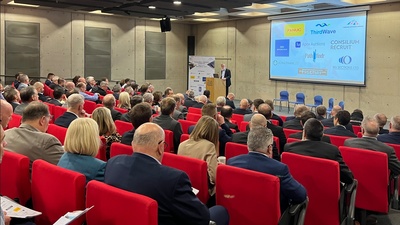
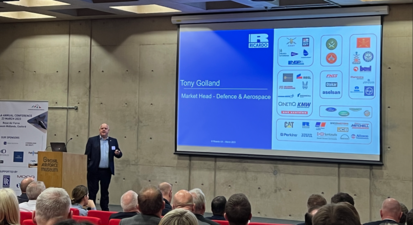
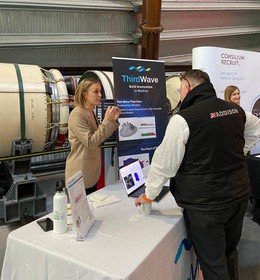
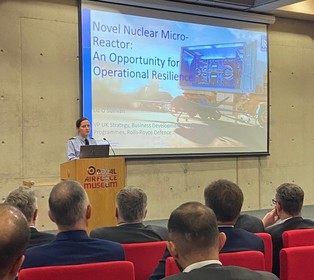


More photos courtesy of the Royal Air Force Museum Midlands
